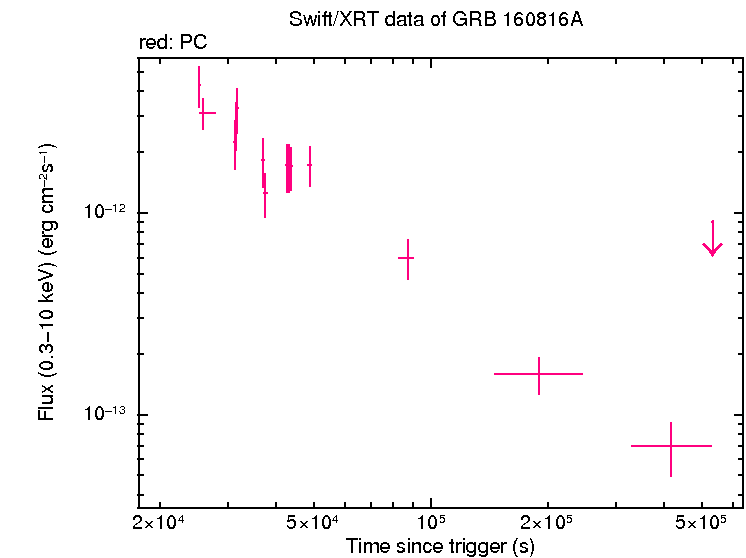
J.A. Kennea (PSU) and P. Kuin (UCL/MSSL) for the Swift team
Racusin et al. (GCN Circ. 19802) reported the GRB detection. At 17:30:58 on August 16, 2016 Fermi-LAT detected high-energy emission from GRB 160816A, which was also detected by Fermi-GBM (trigger 493061460 / 160816730). Table 1 contains the best reported positions from Swift.
Troja et al. (GCN Circ. 19809) reported the position from RATIR for the optical afterglow of this GRB. Kuin et al. (GCN Circ. 19815) reported the detection with UVOT of an optical afterglow. Table 2 is a summary of GCN Circulars about this GRB from observatories other than Swift.
BAT did not observe this burst.
XRT refined results are not available.
The Swift/UVOT began settled observations
(Kuin et al. GCN Circ. 19815) of the field of the Fermi/LAT- detected GRB 160816A 25222 s after the LAT trigger (Racusin et al. GCN Circ. 19802).
A source consistent with the XRT position (Kennea et al. GCN Circ. 19806) and the LCOGT Faulkes Telescope North position (Guidorzi et al., GCN Circ. 19808) is detected in the initial UVOT exposures at the same position as reported by RATIR (Troja et al. GCN.
Table 3 gives preliminary
magnitudes using the UVOT photometric system
(Breeveld et al. 2011, AIP Conf. Proc., 1358, 373).
No correction has been made for the expected extinction in the Milky Way
corresponding to a reddening of
Figure 1. The BAT light curve is not available.

Figure 2. The XRT light curve.
Any data from a crosshatched region are not included in the fit.
| RA (J2000) | Dec (J2000) | Error | Note | Reference |
|---|---|---|---|---|
| 2 |
+37°07'58.3" | 1.6" | XRT-final | UKSSDC |
| 2 |
+37°07'56.6" | 3.8" | XRT | Kennea et al. GCN Circ. 19806 |
| Band | Authors | GCN Circ. | Subject | Observatory | Notes |
|---|---|---|---|---|---|
| Optical | Lipunov et al. | 19805 | MASTER inspection | MASTER | upper limits |
| Optical | Guidorzi et al. | 19808 | LCOGT-FTN optical candidate | FTN | detection |
| Optical | Troja et al. | 19809 | RATIR Optical and NIR Observations | RATIR | |
| Optical | Kitaoka et al. | 19818 | iTelescope observation | iTelescope | |
| Optical | Guidorzi et al. | 19819 | confirmed fading with the LT | Liverpool Telescope | |
| Optical | Troja et al. | 19820 | RATIR Optical and NIR Afterglow Confirmation |
RATIR | detection |
| Optical | Tyurina et al. | 19821 | MASTER OT early detection on coaded images |
MASTER | detection |
| Optical | Troja et al. | 19824 | Further RATIR Optical and NIR Observations |
RATIR | detection |
| Optical | Mazaeva et al. | 19825 | ISON/UAFO optical observations | ISON-Ussuriysk | detection |
| Optical | Mazaeva et al. | 19829 | TSHAO optical observations | Zeiss-1000 | detection |
| Radio | Mooley et al. | 19892 | Possible radio afterglow detection at 15 GHz with AMI |
AMI | possible detection |
| Gamma-ray | Racusin et al. | 19802 | Fermi-LAT detection | Fermi LAT | |
| Gamma-ray | Mailyan and Meegan | 19804 | 730A: Fermi GBM detection/observation | Fermi GBM | Fluence=3.467±0.037x1 (9 |
| Gamma-ray | Svinkin et al. | 19810 | Konus-Wind observation | Konus-Wind | Duration=~14 seconds Fluence=3.16(-0.10,+0.11)x1 |
| Gamma-ray | Hurley et al. | 19814 | IPN annulus | IPN | |
| Other | 19881 | the review of the sky area in plate archives |
| Filter | Exp(s) | Mag | ||
|---|---|---|---|---|
| white | 27601 | 43846 | 879 | 21.48 ± 0.22 |
| v | 27661 | 27703 | 41 | >17.9 |
| u | 25222 | 37523 | 2287 | 21.37 ± 0.31 |
Table 3. UVOT observations reported by Kuin et al. (GCN Circ. 19815). The start and stop times of the exposures are given in seconds since the BAT trigger. The preliminary detections and 3-σ upper limits are given. No correction has been made for extinction in the Milky Way.
September 6, 2016